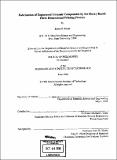| dc.contributor.advisor | Michael J. Cima. | en_US |
| dc.contributor.author | Grau, Jason Elliot | en_US |
| dc.date.accessioned | 2005-08-19T18:43:08Z | |
| dc.date.available | 2005-08-19T18:43:08Z | |
| dc.date.copyright | 1998 | en_US |
| dc.date.issued | 1998 | en_US |
| dc.identifier.uri | http://hdl.handle.net/1721.1/9584 | |
| dc.description | Thesis (Ph.D.)--Massachusetts Institute of Technology, Dept. of Materials Science and Engineering, 1998. | en_US |
| dc.description | Includes bibliographical references (p. 227-234). | en_US |
| dc.description.abstract | The slurry-based 3DP process is a novel process that has been developed for fabricating engineered ceramic components. The process is a solid freeform fabrication (SFF) technique that builds components directly from a computer CAD file on a layer-by-layer basis. Solid-liquid interactions play a primary role in the process physics of each stage of the process. The formation of the powder bed is the first critical step in the slurry-based 3DP process. Powder bed microstructure is controlled by slurry stability and the slip casting rate. Capillary pressure must be controlled to produce crack-free powder beds. A critical saturation thickness (CST) was identified above which powder beds would crack. The CST increased with variables that reduced the capillary pressure. Conditions to fabricate crack-free powder beds using a multi-layer slurry deposition process were outlined. Solid-liquid interactions also affected the rate of infiltration of liquid into the powder bed. The rate of liquid infiltration affected the binder infiltration into the powder bed and the slip casting rate of the slurry. Slip casting rates of the slurry differed for regions of the powder bed printed with binder. The differential casting kinetics lead to two phenomena: density variation and slurry migration. The packing density of powder beds was higher in regions printed with binder, indicating that the density was higher in regions with lower casting rates. Slurry migration occurred due to the difference in liquid flux over the binder-printed region compared to the unprinted region of the powder bed. A model of the slip casting process was developed to identify variables to minimize the differential casting kinetics. The contact angle of the solvent and volume fraction of binder printed into the part affect the casting rate. The relative magnitude of the contact angles was calculated for a given volume fraction of binder to match the casting kinetics. This fundamental understanding of the solid-liquid interactions indicates routes to fabricate engineered ceramic components from numerous materials systems. Alumina components with green densities greater than 60% theoretical and sintered densities greater than 99% were fabricated. The general process has also been applied to silicon nitride. | en_US |
| dc.description.statementofresponsibility | by Jason E. Grau. | en_US |
| dc.format.extent | 234 leaves | en_US |
| dc.format.extent | 17350359 bytes | |
| dc.format.extent | 17350118 bytes | |
| dc.format.mimetype | application/pdf | |
| dc.format.mimetype | application/pdf | |
| dc.language.iso | eng | en_US |
| dc.publisher | Massachusetts Institute of Technology | en_US |
| dc.rights | M.I.T. theses are protected by copyright. They may be viewed from this source for any purpose, but reproduction or distribution in any format is prohibited without written permission. See provided URL for inquiries about permission. | en_US |
| dc.rights.uri | http://dspace.mit.edu/handle/1721.1/7582 | |
| dc.subject | Materials Science and Engineering | en_US |
| dc.title | Fabrication of engineered ceramic components by the slurry-based three dimensional printing process | en_US |
| dc.type | Thesis | en_US |
| dc.description.degree | Ph.D. | en_US |
| dc.contributor.department | Massachusetts Institute of Technology. Department of Materials Science and Engineering | en_US |
| dc.identifier.oclc | 42078076 | en_US |

